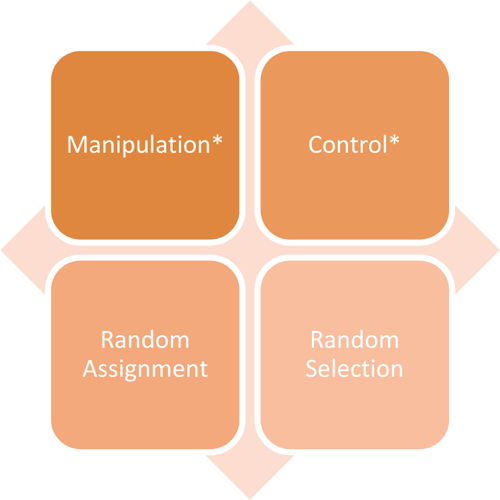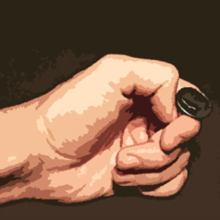Module 2: Research Design - Section 2
Section 2: Experimental Studies
Unlike a descriptive study, an experiment is a study in which a treatment, procedure, or program is intentionally introduced and a result or outcome is observed. The American Heritage Dictionary of the English Language defines an experiment as "A test under controlled conditions that is made to demonstrate a known truth, to examine the validity of a hypothesis, or to determine the efficacy of something previously untried."
 True experiments have four elements: manipulation, control , random assignment, and random selection. The most important of these elements are manipulation and control. Manipulation means that something is purposefully changed by the researcher in the environment. Control is used to prevent outside factors from influencing the study outcome. When something is manipulated and controlled and then the outcome happens, it makes us more confident that the manipulation "caused" the outcome. In addition, experiments involve highly controlled and systematic procedures in an effort to minimize error and bias, which also increases our confidence that the manipulation "caused" the outcome.
True experiments have four elements: manipulation, control , random assignment, and random selection. The most important of these elements are manipulation and control. Manipulation means that something is purposefully changed by the researcher in the environment. Control is used to prevent outside factors from influencing the study outcome. When something is manipulated and controlled and then the outcome happens, it makes us more confident that the manipulation "caused" the outcome. In addition, experiments involve highly controlled and systematic procedures in an effort to minimize error and bias, which also increases our confidence that the manipulation "caused" the outcome.
 Another key element of a true experiment is random assignment. Random assignment means that if there are groups or treatments in the experiment, participants are assigned to these groups or treatments, or randomly (like the flip of a coin).
Another key element of a true experiment is random assignment. Random assignment means that if there are groups or treatments in the experiment, participants are assigned to these groups or treatments, or randomly (like the flip of a coin).
This means that no matter who the participant is, he/she has an equal chance of getting into all of the groups or treatments in an experiment. This process helps to ensure that the groups or treatments are similar at the beginning of the study so that there is more confidence that the manipulation (group or treatment) "caused" the outcome. More information about random assignment may be found in section Random assignment.
Definition: An experiment is a study in which a treatment, procedure, or program is intentionally introduced and a result or outcome is observed.
Case Example for Experimental Study
Experimental Studies — Example 1
An investigator wants to evaluate whether a new technique to teach math to elementary school students is more effective than the standard teaching method. Using an experimental design, the investigator divides the class randomly (by chance) into two groups and calls them "Group A" and "Group B." The students cannot choose their own group. The random assignment process results in two groups that should share equal characteristics at the beginning of the experiment.  In Group A, the teacher uses a new teaching method to teach the math lesson. In Group B, the teacher uses a standard teaching method to teach the math lesson. The investigator compares test scores at the end of the semester to evaluate the success of the new teaching method compared to the standard teaching method. At the end of the study, the results indicated that the students in the new teaching method group scored significantly higher on their final exam than the students in the standard teaching group.
In Group A, the teacher uses a new teaching method to teach the math lesson. In Group B, the teacher uses a standard teaching method to teach the math lesson. The investigator compares test scores at the end of the semester to evaluate the success of the new teaching method compared to the standard teaching method. At the end of the study, the results indicated that the students in the new teaching method group scored significantly higher on their final exam than the students in the standard teaching group.
Experimental Studies — Example 2
A fitness instructor wants to test the effectiveness of a performance-enhancing herbal supplement on students in her exercise class. To create experimental groups that are similar at the beginning of the study, the students are assigned into two groups at random (they can not choose which group they are in). Students in both groups are given a pill to take every day, but they do not know whether the pill is a placebo (sugar pill) or the herbal supplement. The instructor gives Group A the herbal supplement and Group B receives the placebo (sugar pill). The students' fitness level is compared before and after six weeks of consuming the supplement or the sugar pill. No differences in performance ability were found between the two groups suggesting that the herbal supplement was not effective.





